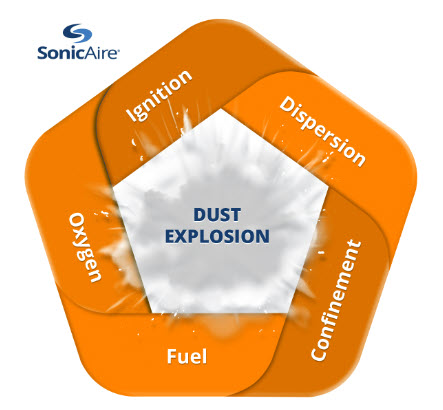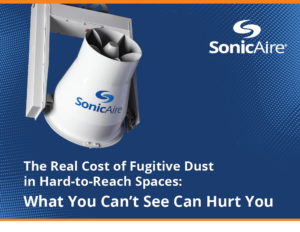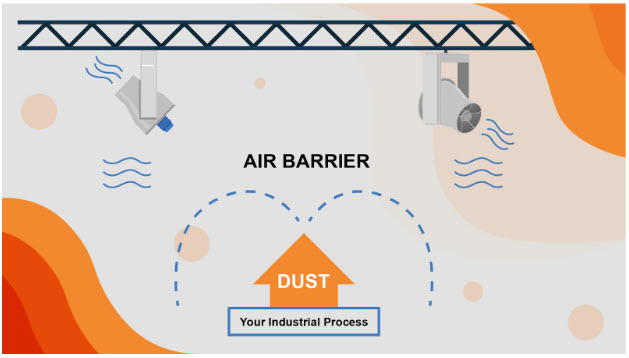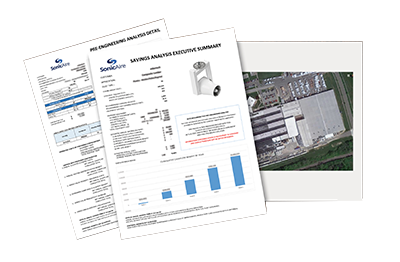In the heart of a bustling feed mill, a silent threat looms, often overlooked for machinery clamor and workers’ bustle. This threat is fugitive dust—tiny particles that, when airborne, can pose serious health and safety hazards. Invisible to the naked eye, these particles can find their way into workers’ lungs, leading to chronic respiratory issues. But the danger doesn’t stop there. In industries with combustible dust, like feed mills and grain facilities, even a small ignition source can turn these particles into a ticking time bomb, leading to catastrophic explosions. These explosions can cause severe injuries, fatalities, property damage, and even complete facility destruction.
Furst-McNess’ Commitment to Safety
In the Furst-McNess facility, Ron Kerkhoff, a seasoned expert in the grain and feed industry, understands the importance of prioritizing safety in an environment where dust accumulation is a constant threat. He knows that strict adherence to Occupational Safety and Health Administration (OSHA) guidelines is not just a regulatory requirement but a crucial measure to prevent dust-related hazards. By meticulously monitoring and controlling dust levels, companies can create safer working environments and protect their employees from the unseen dangers of fugitive dust.
“The last thing you want is to have to tell a family member that your son or your daughter or your husband died in a grain explosion. So, it’s always on the top of mind to do the right thing.” – Ron Kerkhoff.
A Dust-Free Future
Combating fugitive dust is an ever-present, rarely considered concern for manufacturing facility managers and production facilities. Not only does fugitive dust pose safety risks and health hazards, but it also puts businesses at risk of non-compliance with industry regulations. Unfortunately, it’s often lurking in unseen areas of facilities, including overhead spaces and on top of air ducts. Fugitive dust leaks from dust collection systems and off processes, riding thermal currents to hard-to-reach overhead spaces. It’s up to facilities to maintain a safe environment for employees.
Understanding the Significance of Fugitive Dust
The Hazards of Fugitive Dust
Fugitive dust consists of fine particles that become airborne during various industrial processes. They escape dust collectors and reactive dust control measures. These tiny particles may seem insignificant but can lead to severe consequences. Exposure to fugitive dust can cause respiratory issues, eye irritation, skin problems, and even long-term health complications.
Of course, dust concerns don’t end there. Some types of dust are combustible, requiring additional precautions. When combustible dust accumulates, it becomes a lurking danger, increasing the risk of fires and explosions within facilities. Facilities that proactively address fugitive dust concerns prioritize the safety and well-being of their workforce while minimizing potential liabilities.
Common Sources of Fugitive Dust
Fugitive dust can originate from several sources, depending on the industry. Common culprits include cutting, grinding, sanding, mixing, conveying, and packaging operations.
Sawdust and wood particles are significant contributors to fugitive dust in woodworking. Similarly, paper production generates dust through pulp handling and drying processes.
Remember the five requirements for a dust explosion, as shown above.
Ignition Sources
There are numerous potential ignition sources within facilities, including:
- Machinery and Equipment: Friction, overheating, or mechanical failure can produce sparks or hot surfaces.
- Electrical Systems: Faulty wiring, switches, and other electrical components can generate sparks.
- Static Electricity: Dust particles can generate static electricity, igniting dust clouds.
The Regulatory Landscape for Fugitive Dust Control
Regulatory bodies such as OSHA have established guidelines based on the NFPA standards for controlling fugitive dust to ensure worker safety and environmental protection. Companies must comply with these regulations to avoid penalties, legal ramifications, and reputational damage. Implementing robust fugitive dust control measures helps maintain compliance and enhances overall operational efficiency. It is essential to stay informed about relevant regulations and partner with experts who can provide tailored solutions to meet compliance requirements.
Best Practices and Considerations to Eliminate the Risk of Fugitive Dust
After fully grasping the risk of fugitive combustible dust, one must consider some of the best practices and solutions available.
Assess Facility Needs and Challenges
Assessing a facility’s unique needs and challenges is essential before embarking on any dust control initiative. Identify dust generation points, airflow patterns, and specific requirements to determine the most effective application of SonicAire’s technology.
Training and Education for Effective Dust Control
Effective dust control goes hand in hand with employee training and education. Employees should receive comprehensive training on dust management practices. This training must cover the importance of combustible dust control and how it affects their safety, efficiency, and health. Empower employees to proactively maintain a clean and safe work environment by ensuring they understand the dangers of dust build up and clean the dust before it poses a risk.
BarrierAire™ Technology from SonicAire
SonicAire’s revolutionary BarrierAire™ technology offers a game-changing tactic to eliminate the risks associated with overhead fugitive dust.
How Does BarrierAire™ Technology Work?
SonicAire’s BarrierAire™ technology utilizes high-velocity horizontal air curtains strategically placed near dust-producing equipment. These air curtains act as barriers, preventing fugitive dust from rising into overhead spaces. Unlike traditional methods that rely solely on filtration or cleaning, BarrierAire™ stops the problem at its source. There are no filters to change. Just dust on the floor to sweep up at the end of the day. Dust that would have been in the ceiling otherwise. By disrupting the natural path of airborne particles, our technology effectively controls fugitive dust dispersion, improving air quality and reducing accumulation.
Immediate Benefits for Businesses
By effectively controlling fugitive dust, facilities can reduce cleanup time and maintenance costs associated with dust removal. Additionally, improved air quality leads to a healthier and happier workforce, increasing productivity and reducing employee absenteeism and turnover. With SonicAire supporting a facility’s dust control efforts, management can rest easy, knowing their facility complies with regulations while creating a safe work environment.
Custom Fan Layouts for Maximum Efficiency and Effect
Every manufacturing facility has unique challenges and requirements regarding fugitive dust control. To effectively manage combustible dust in a facility, tailor-made solutions are necessary. SonicAire’s specialized engineers work closely with facility managers to assess their needs and design optimized fan layouts. We consider equipment placement, budgetary requirements, DHA recommendations, and workflow dynamics to ensure maximum efficiency and effectiveness. With custom fan layouts, each fan is in the most effective spot for the safety of employees and the facility. This is not a fan-in-a-box experience. We offer a compliance guarantee if the fans are installed as recommended.
Industries Benefiting from SonicAire Solutions
SonicAire’s BarrierAire™ technology caters to several industries facing fugitive dust challenges.
Grain and Feed Mills
Due to the nature of their operations, grain and feed mills face significant combustible dust risks. They are one of the most common sources of combustible dust events, and for good reason.
According to Ag Safety “The minimum explosive concentration (MEC) of grain dust is the minimum concentration of combustible dust suspended in air that can support deflagration. It’s also known as the lower explosible limit (LEL). The MEC is a measurement of the dust’s particle size and energy nature and can vary depending on the type of grain. Some experts say the MEC is 50 grams per cubic meter (g/m3), while others say it’s between 50 and 150 g/m3, depending on the dust and particle size. The National Grain and Feed Association (NGFA) says the MEC is about 0.05 ounces per cubic foot of volume.”
Grain dust is highly combustible and can ignite even when suspended in the air. This fine dust can form explosive dust clouds that pose a severe risk of fire and explosion if exposed to an ignition source such as sparks, hot surfaces, or electrical equipment.
Dust tends to accumulate on equipment, floors, rafters, and other surfaces. This buildup can create a thick layer of dust that, in grain and feed facilities, becomes airborne during the milling process and transfer, creating explosive dust clouds. Regular cleaning is often difficult, especially in hard-to-reach areas, leading to increased risk.
Facility managers should also consider that the labor required for this isn’t a given. The grain industry has an undeniable and significant labor shortage; according to the Canadian Agricultural Human Resource Council (CAHRC), it’s a “severe and chronic” struggle.
Additionally, if you operate a Class II, Division I environment, SonicAire has the only certified dust control fans for those high-risk facilities.
Woodworking and Furniture Manufacturing
Woodworking and furniture manufacturing facilities generate substantial amounts of fugitive wood dust during the cutting, sanding, and finishing processes. This dust creates a potentially hazardous environment for both workers and equipment. Sawdust is highly combustible; should the worst occur, there’s very little opportunity to control a fire; it will simply explode.
Paper Production and Printing
Paper mills, tissue converting, and corrugating packaging face unique challenges due to fugitive dust generated during various stages of the manufacturing process. From raw material handling to trimming and converting, adequate dust control is vital to prevent contamination and maintain the quality of finished products. SonicAire’s BarrierAire™ technology offers a proactive approach to address these challenges, reducing downtime caused by frequent cleaning, ensuring cleaner paper surfaces, and optimizing overall production efficiency.
Plastics Processing and Textiles
Plastics processing and textile industries heavily rely on cutting, shaping, molding, and extrusion processes that produce significant amounts of fugitive combustible dust. Without proper control measures, this dust can compromise product quality, impact machinery performance, and endanger workers’ health. Mitigating these risks allows businesses to focus on meeting production targets without compromising safety, compliance, or profitability.
Ensuring Safety and Compliance
When it comes to fugitive dust control, safety and compliance go hand in hand. SonicAire provides comprehensive solutions that enable businesses to meet regulatory requirements and safeguard their employees.
Preventing Combustion Events with SonicAire
One of the most significant dangers associated with fugitive dust is its potential to ignite and cause fires or explosions. Combustible materials like wood, plastic, and paper can become highly reactive when suspended in the air. SonicAire’s BarrierAire™ technology acts as a preventive measure, curtailing the dispersal of combustible dust and significantly reducing the risk of combustion events. Investing in SonicAire protects employees, equipment, and facilities from catastrophic incidents.
OSHA Standards and Compliance Requirements
Regulatory agencies like OSHA establish and enforce standards to protect workers from workplace hazards, including combustible dust. OSHA’s Combustible Dust National Emphasis Program emphasizes the need for facilities to implement effective dust control strategies. If a facility is to stay compliant, it will need someone on the team who stays up-to-date with these regulations and ensures its solutions align with OSHA standards.
At SonicAire, we’re so confident you’ll maintain compliance with our dust control fans that we guarantee it.
Partnering with SonicAire for Peace of Mind
Choosing SonicAire as your fugitive dust control partner means gaining peace of mind. Our dedicated team of experts provides ongoing support, helping you navigate the complexities of dust control and compliance. We work closely with facility managers, offering guidance, training, and continuous monitoring to optimize system performance. Together, we create an atmosphere of safety, productivity, and confidence throughout your facility.
A Breath of Fresh Air
Fugitive dust poses significant risks to both personnel and businesses. With a SonicAire dust control system, manufacturing and processing facilities can create a safer, healthier work environment while maintaining compliance with industry regulations. By proactively addressing fugitive dust issues, management can enhance operational efficiency, protect valuable assets, and cultivate a culture of safety within their facility.
So, what happened to Furst-McNess Animal Fedd Mills? To keep their facility safe, they installed SonicAire’s dust control fans, specially designed to handle the fugitive dust in Class II, Division 1 environments (Where dust is a constant presence and a part of day-to-day operations). They’re the only fans certified to handle dust with this classification; for more on that, check their blog introduction.
By implementing effective dust control measures, they’ve ensured compliance with dust regulations and protected their employees and equipment from the hazards associated with dust accumulation.
At SonicAire, we are committed to helping you create a safer, healthier, and more productive work environment. Request a quote today and embark on the journey toward a dust-free future.
Fugitive Dust Control: Creating a Safer, Healthier Work Environment
Imagine entering your manufacturing facility without worrying about the harmful effects of fugitive dust. With SonicAire’s innovative BarrierAire™ technology, you can breathe easy knowing that your work environment is safer and healthier. When you’re evaluating the risks and potential solutions, consider how you’re going to eliminate fugitive dust issues, ensure regulatory compliance, and enhance productivity in diverse industries. From woodworking to food processing, SonicAire is here to provide you with the expertise and fan systems to create a fugitive dust-free facility.
A Dust-Free Future
Combating fugitive dust is an ever-present, rarely considered concern for manufacturing facility managers and production business owners. Not only does fugitive dust pose safety risks and health hazards, but it also puts businesses at risk of non-compliance with industry regulations. Unfortunately, it’s often lurking in unseen areas of your facility, including overhead spaces and air ducts. To create a safer, healthier, and more efficient work environment, eliminating that fugitive dust problem must be a priority.
Understanding the Significance of Fugitive Dust
Before exploring how SonicAire tackles fugitive dust issues, you have to understand what it is and why it demands so much of your attention.
The Hazards of Fugitive Dust
Fugitive dust consists of fine particles that become airborne during various industrial processes. These tiny particles may seem insignificant but can lead to severe consequences. Exposure to fugitive dust can cause respiratory issues, eye irritation, skin problems, and even long-term health complications.
Of course, with dust, it’s never that simple. Some types of dust are combustible, requiring additional precautions. When combustible dust accumulates, it becomes a lurking danger, increasing the risk of fires and explosions within facilities. Facilities that proactively address fugitive dust concerns prioritize the safety and well-being of their workforce while minimizing potential liabilities.
Common Sources of Fugitive Dust
Fugitive dust can originate from several sources depending upon the industry. Common culprits include cutting, grinding, sanding, mixing, conveying, and packaging operations. Sawdust and wood particles are significant contributors to fugitive dust in woodworking. Similarly, paper production generates dust through pulp handling and drying processes.
Though we’ll discuss the specifics of several industries later, it’s important to consider how easily a combustion event can occur.

Remember the five requirements for a dust explosion, as shown above.
Ignition Sources
There are numerous potential ignition sources within facilities, including:
- Machinery and Equipment: Friction, overheating, or mechanical failure can produce sparks or hot surfaces.
- Electrical Systems: Faulty wiring, switches, and other electrical components can generate sparks.
- Static Electricity: Dust particles can generate static electricity, igniting dust clouds.
The Regulatory Landscape for Fugitive Dust Control
Regulatory bodies such as OSHA and NFPA have established guidelines and standards for controlling fugitive dust to ensure worker safety and environmental protection. Companies must comply with these regulations to avoid penalties, legal ramifications, and reputational damage. Implementing robust fugitive dust control measures helps maintain compliance and enhances overall operational efficiency. It is essential to stay informed about relevant regulations and partner with experts who can provide tailored solutions to meet compliance requirements.
Best Practices and Considerations to Eliminate the Risk of Fugitive Dust
After fully grasping the risk, you must consider some of the best practices and solutions available.
Assess Facility Needs and Challenges
Assessing your facility’s unique needs and challenges is essential before embarking on any dust control initiative. Identify dust generation points, airflow patterns, and specific requirements to determine the most effective application of SonicAire’s technology.
Training and Education for Effective Dust Control
Effective dust control goes hand in hand with employee training and education. Ensure that your workforce receives comprehensive training on dust management practices, including the importance of dust control to compliance and their own safety. Empower your employees to maintain a clean and safe work environment proactively.
BarrierAire™ Technology from SonicAire
SonicAire’s revolutionary BarrierAire™ technology offers a game-changing tactic to mitigate the risks associated with fugitive dust.
How Does BarrierAire™ Technology Work?
SonicAire’s BarrierAire™ technology utilizes high-velocity air curtains strategically placed near dust-producing equipment. These air curtains act as barriers, preventing fugitive dust from escaping into the surrounding areas. Unlike traditional methods that rely solely on filtration or cleaning, BarrierAire™ stops the problem at its source. By disrupting the natural path of airborne particles, our technology effectively controls fugitive dust dispersion, improving air quality and reducing accumulation.
Immediate Benefits for Your Business
Investing in SonicAire’s BarrierAire™ technology brings immediate benefits to your business. By effectively containing fugitive dust, you reduce cleanup time and maintenance costs associated with dust removal. Additionally, improved air quality leads to a healthier and happier workforce, increasing productivity and reducing employee absenteeism. With SonicAire as your partner, you can enjoy the peace of mind of knowing your facility complies with regulations while creating a safe and conducive work environment.
Custom Fan Layouts for Maximum Efficiency
Every manufacturing facility has unique challenges and requirements regarding fugitive dust control. To effectively manage combustible dust in your facility, you need tailor-made solutions. SonicAire’s specialized engineers work closely with facility managers to assess their needs and design optimized fan layouts. We consider airflow patterns, equipment placement, and workflow dynamics to ensure maximum efficiency and effectiveness. With custom fan layouts, you can minimize fugitive dust-related risks and maximize operational productivity.
Industries Benefiting from SonicAire Solutions
SonicAire’s BarrierAire™ technology caters to several industries facing fugitive dust challenges.
Grain and Feed Mills
Due to the nature of their operations, grain and feed mills face significant combustible dust risks. They are one of the most common sources of combustible dust events, and for good reason. These facilities handle and process large quantities of grain and other agricultural products, generating substantial amounts of fine dust particles.
Grain dust is highly combustible and can ignite even when suspended in the air. This fine dust can form explosive dust clouds that pose a severe risk of fire and explosion if exposed to an ignition source such as sparks, hot surfaces, or electrical equipment.
In grain and feed mills, dust tends to accumulate on equipment, floors, rafters, and other surfaces. This buildup can create a thick layer of dust that, when disturbed, can become airborne and create explosive dust clouds. Regular cleaning is often difficult, especially in hard-to-reach areas, leading to increased risk.
Woodworking and Furniture Manufacturing
Woodworking and furniture manufacturing facilities generate substantial amounts of fugitive wood dust during the cutting, sanding, and finishing processes. This dust creates a potentially hazardous environment for both workers and equipment. You likely don’t need to be told that paper is flammable, but it’s absolutely worth mentioning that sawdust is also highly combustible. That means there’s every possibility that should the worst occur, you won’t even have the opportunity to control the fire before it explodes.
Paper Production and Printing
The paper production and printing industry faces unique challenges due to fugitive dust generated during various stages of the manufacturing process. From raw material handling to trimming and converting, adequate dust control is vital to prevent contamination and maintain the quality of finished products. SonicAire’s BarrierAire™ technology offers a proactive approach to address these challenges, reducing downtime caused by frequent cleaning, ensuring cleaner paper surfaces, and optimizing overall production efficiency.
Plastics Processing and Textiles
Plastics processing and textile industries heavily rely on cutting, shaping, molding, and extrusion processes that produce significant amounts of fugitive dust. Without proper control measures, this dust can compromise product quality, impact machinery performance, and endanger workers’ health. Mitigating these risks allows businesses to focus on meeting production targets without compromising safety, compliance, or profitability.
You should also remember that if you operate a Class II, Division I environment, SonicAire has the only certified dust control fans for those high-risk facilities.
Ensuring Safety and Compliance
When it comes to fugitive dust control, safety and compliance go hand in hand. SonicAire provides comprehensive solutions that enable businesses to meet regulatory requirements and safeguard their employees.
Preventing Combustion Events with SonicAire
One of the most significant dangers associated with fugitive dust is its potential to ignite and cause fires or explosions. Combustible materials like wood, plastic, and paper can become highly reactive when suspended in the air. SonicAire’s BarrierAire™ technology acts as a preventive measure, curtailing the dispersal of combustible dust and significantly reducing the risk of combustion events. Investing in SonicAire protects your employees, equipment, and facility from catastrophic incidents.
OSHA Standards and Compliance Requirements
Regulatory agencies, such as OSHA and the NFPA, establish and enforce standards to protect workers from workplace hazards, including combustible dust. OSHA’s Combustible Dust National Emphasis Program emphasizes the need for facilities to implement effective dust control strategies. If your facility is to stay compliant, you’ll need a team that stays up-to-date with these regulations and ensures our solutions align with OSHA standards.
At SonicAire, we’re so confident you’ll maintain compliance with our dust control fans that we guarantee it.
Partnering with SonicAire for Peace of Mind
Choosing SonicAire as your fugitive dust control partner means gaining peace of mind. Our dedicated team of experts provides ongoing support, helping you navigate the complexities of dust control and compliance. We work closely with facility managers, offering guidance, training, and continuous monitoring to optimize system performance. Together, we create an atmosphere of safety, productivity, and confidence throughout your facility.
A Breath of Fresh Air
Fugitive dust poses significant risks to both personnel and businesses. With SonicAire’s BarrierAire™ technology, you can create a safer, healthier work environment while maintaining compliance with industry regulations. By proactively addressing fugitive dust issues, you enhance operational efficiency, protect valuable assets, and cultivate a culture of safety within your facility.
At SonicAire, we are committed to helping you create a safer, healthier, and more productive work environment. Request a quote today and embark on the journey toward a dust-free future.

GET YOUR FREE GUIDE:
The Real Cost of Fugitive Dust in Hard-to-Reach Spaces
What You Can’t See Can Hurt You
To help protect your workplace, we’ve compiled the following resource, The Real Cost of Fugitive Dust in Hard-to-Reach Spaces: What You Can’t See Can Hurt You. In it, we identify seven ways fugitive dust is likely impacting your facility and its profitability.
These costs go beyond housekeeping and explain why you should be preventing dust buildup to protect the bottom line, not just to stay in compliance.


